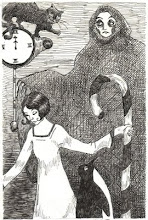 Oh, Alice White.
Oh, Alice White.The only reason she's re-entered the public's consiousness is because she is the subject of seemingly dozens of utterly charming publicity stills from the late '20s and through the '30s. I have a strong suspicion that the vast majority of those who are won over by her adorableness have never seen any of her pictures.
A few weeks ago we emerged from Cabinet Headquarters and ventured over to Film Forum where we were lucky enough to catch the rarely screened 1930 flick, Show Girl in Hollywood. As I mentioned in yesterday's post, I have a particular fondness for the early sound musicals. Show Girl, like all of them, is a backstage musical, this one based on J.P. McEvoy's novel of the same name, featuring his show girl creation, Dixie Dugan.
The novel was serialized in Liberty Magazine in 1929, and as in its comic strip spin-off, the chorus girl protagonist was modeled after that most problematic and interesting Ziegfeld alum, Miss Louise Brooks. See below:
 A first, silent Dixie Dugan flick, titled simply "Show Girl" was made in 1928, also starring Alice White. Prints exist, but it's not available on either DVD or online, unfortunately. The real question is: why was Louise Brooks never even considered to play the part which was based on her? The ways of Hollywood were and are still inexplicable. Show Girl was made by First National and Brooks was signed to Paramount (though she had been loaned out to First National before), and the studio wanted to promote their own version of Clara Bow, Alice White. The picture didn't do that well (neither did Ziegfeld's stage version of 1929 starring Ruby Keeler with songs by Gershwin), but a sequel was made a couple of years later once sound was introduced.
A first, silent Dixie Dugan flick, titled simply "Show Girl" was made in 1928, also starring Alice White. Prints exist, but it's not available on either DVD or online, unfortunately. The real question is: why was Louise Brooks never even considered to play the part which was based on her? The ways of Hollywood were and are still inexplicable. Show Girl was made by First National and Brooks was signed to Paramount (though she had been loaned out to First National before), and the studio wanted to promote their own version of Clara Bow, Alice White. The picture didn't do that well (neither did Ziegfeld's stage version of 1929 starring Ruby Keeler with songs by Gershwin), but a sequel was made a couple of years later once sound was introduced.Back to Alice White. She is, inarguably, adorable. But she's not much of an actor. She mugs and is stilted. Her singing voice is dubbed and she's a barely adequate dancer. But, as mentioned previously, she's super adorable, a trait which has launched the career of many a starlet past and present. But, adorable does not a career make and Miss White's floundered as she became enmeshed in a tabloid sex scandal (also not uncommon among starlets past and present) and her career never recovered. One way in which she does differ from many starlets is that she was a girl with a college education who began her career working behind the camera. She was Erich Von Stroheim's script girl, but he eventually fired her. She then worked for Charlie Chaplin, who first put her in front of the camera, a goal I have a feeling she may have achieved via the Chaplin casting couch.
White made lots of silent comedies and then segued nicely into sound, but never really hit the big time. One can't help but wonder what the Dixie Dugan series would have been like had Louise Brooks (below right) starred. Alice White's gigantic peepers and baby-doll Brooklynese are charming enough, but Brooks had a great deal more force and charisma and was sexy as hell. And she was an actual Ziegfeld star, unlike Alice White who only performed on film.
This film itself is more interesting as historical curiosity than for its own merits. It's one of the only early talkies that shows the actual movie making process. In the film, Dixie befriends a fading silent screen star, played by Blanche Sweet, aging silent film star. Though, please mind, I use the phrase "aging" advisedly. Sweet's character is written and filmed as if she's on the verge of Norma Desmond-hood, but then she cries out with anguish, "I'm thirty-two years old!". In the screening I attended, this was not greeted by the audience with understanding and pity, but with great big gales of laughter.
As with Glorifying the American Girl, the last reel of Show Girl in Hollywood was shot in color, but in this instance all copies have been lost, and only black and white versions remain. Like in the Ziegfeld movie, there is s scene in which actual stars attend the premier of Dixie's movie. We are then treated to one of the strangest musical numbers I've ever seen (which is saying a lot, as I've seen some very strange musical numbers indeed). The song is called "Haywire" and in order to demonstrate "crazy" the filmmakers have chosen to include these bizarre dancing... figures. They look like homeless people possibly, or maybe the legendary Mole People who supposedly live below the streets of New York. It is so weird. You can see the whole sequence below:
All my caveats aside, I am beyond pleased to have gotten to see this curious picture on the big screen. And though one can't help but dream of a Brooks inhabited alternate reality version, it's a fascinating and entertaining curiosity.



















No comments:
Post a Comment